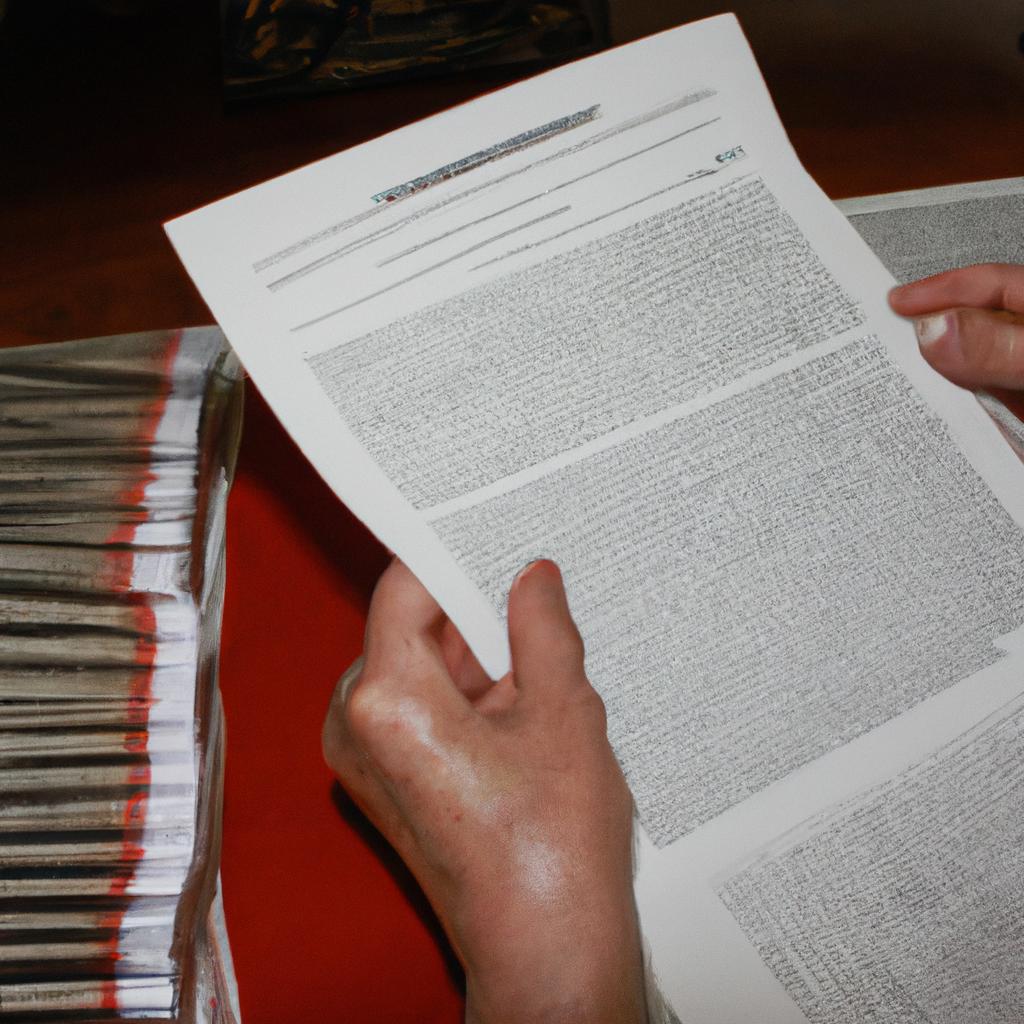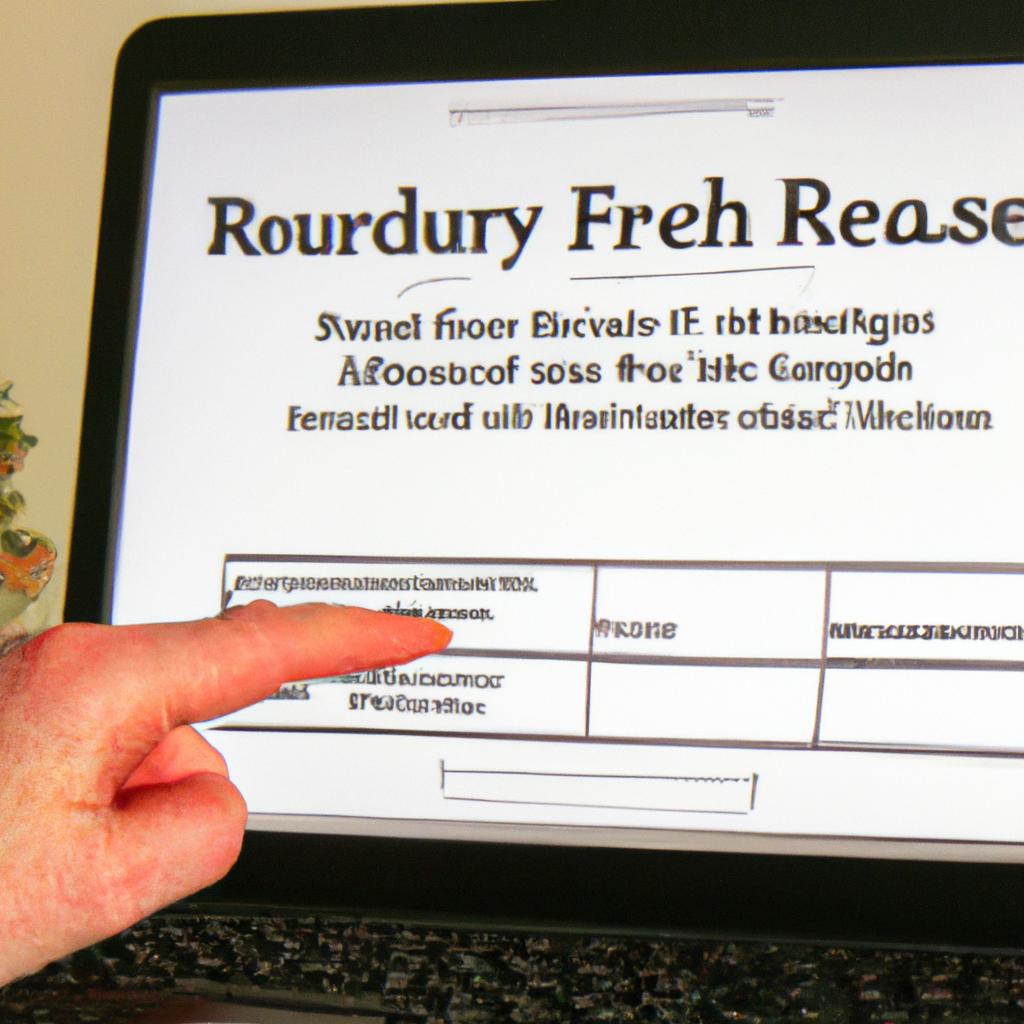Primary sources play a crucial role in genealogy education, providing valuable insights and information about ancestral lineages. The analysis of these primary sources is essential for accurately piecing together the puzzle of one’s family history. For instance, imagine a researcher delving into their ancestry to uncover the truth behind an old family rumor that claims they are descendants of a famous historical figure. By thoroughly examining primary sources such as birth certificates, census records, and letters from ancestors, this researcher can validate or debunk the familial connection with confidence.
In the realm of genealogy education, source analysis serves as a fundamental skill necessary for conducting thorough research and constructing accurate narratives. Through careful examination and critical evaluation of primary sources, researchers can extract relevant details and establish credible evidence to support their findings. This process involves assessing various factors such as the reliability and authenticity of documents, understanding contextual influences, deciphering handwriting styles prevalent during specific time periods, and identifying potential biases or discrepancies in recorded information. By honing their source analysis skills, genealogists not only enhance their ability to navigate complex archival materials but also gain deeper insight into the lives and experiences of their ancestors.
Understanding Primary Sources
Primary sources are the foundation of genealogy research, providing invaluable insights into the lives and experiences of our ancestors. By examining these original documents or artifacts created during the time period under investigation, researchers gain direct access to firsthand accounts and information that cannot be obtained through secondary sources alone.
To illustrate this point, let us consider a hypothetical case study involving a genealogist tracing their family history back to the early 19th century. In their search for information about an ancestor who served in the Civil War, they come across a collection of letters written by him during his time on the battlefield. These primary sources offer unique perspectives on his thoughts, emotions, and daily life during one of the most significant periods in American history.
When analyzing primary sources, it is crucial to approach them with caution and employ critical thinking skills. Here are four key considerations:
- Context: Understanding the historical context surrounding a primary source is essential for interpreting its meaning accurately. Factors such as cultural norms, social conditions, and political events can significantly impact how we interpret the content within these sources.
- Bias: Recognizing potential biases in primary sources is important as they may influence the perspective presented or omit certain aspects altogether. It is vital to question any personal opinions or agendas expressed by authors or creators when evaluating these materials.
- Authenticity: Verifying the authenticity of primary sources is essential in ensuring their reliability. Researchers must employ various methods like cross-referencing multiple sources or consulting expert opinions to validate the accuracy of these materials.
- Limitations: Every primary source has inherent limitations due to factors like preservation issues or incomplete documentation. Acknowledging these limitations allows researchers to make informed judgments about gaps in knowledge or areas where further investigation may be necessary.
By considering these points while studying primary sources, researchers can uncover valuable insights into their ancestors’ lives and better understand historical events through a personal lens.
Moving forward, we will explore the importance of primary sources in genealogy research and how they contribute to a more comprehensive understanding of our familial roots.
Importance of Primary Sources in Genealogy
The analysis of primary sources plays a crucial role in genealogy education. By examining these firsthand accounts, documents, and artifacts, individuals can uncover valuable information about their ancestors and construct an accurate family history. To illustrate this point, let us consider the hypothetical case study of Sarah Johnson, who embarked on a journey to explore her family’s roots.
Sarah began her research by delving into primary sources such as birth certificates, marriage records, and census data. These documents provided factual evidence that allowed her to trace her lineage back several generations. However, understanding primary sources goes beyond simply gathering information; it involves critically evaluating the reliability and context of each source. For instance, Sarah encountered conflicting information regarding her great-grandfather’s birthplace – one document stated he was born in New York while another claimed he was born in Pennsylvania. Through careful analysis of additional primary sources like immigration records and newspaper articles from that time period, she was able to determine that her great-grandfather had indeed been born in Pennsylvania but later moved to New York.
Recognizing the importance of primary sources is essential for anyone engaging in genealogical research. Here are some key reasons why they hold significant value:
- Authenticity: Primary sources provide direct access to historical events or personal experiences.
- Uniqueness: Each primary source is unique and contains distinctive details that cannot be found elsewhere.
- Contextualization: They offer insights into the social, cultural, economic, and political environments surrounding our ancestors’ lives.
- Emotional connection: Examining original letters or photographs allows us to connect with our ancestors on a more personal level.
To further emphasize the significance of analyzing primary sources effectively, we can refer to the following table showcasing different types of primary sources commonly used in genealogical research:
| Type of Primary Source | Description |
|---|---|
| Vital Records | Births, marriages, deaths, and other official records of life events. |
| Land Records | Deeds, property transfers, or land grants that can provide insights into an ancestor’s land ownership. |
| Immigration Records | Passenger lists, naturalization papers, and immigration forms that shed light on ancestral migrations. |
| Personal Correspondence | Letters, diaries, or journals written by ancestors offering personal perspectives on their lives. |
By examining a diverse range of primary sources like those listed above in Sarah Johnson’s case study, researchers are better equipped to uncover hidden information and gain a deeper understanding of their family history.
Types of Primary Sources
Case Study:
Imagine you are tracing your family history back to the 19th century. You come across a handwritten letter from your great-great-grandmother, dated 1865. The letter describes her experiences during the Civil War and provides insights into your family’s origins and struggles during that time. This primary source not only offers valuable information about your ancestor but also allows you to connect with her on a personal level.
Analyzing primary sources is an essential skill in genealogy research as it enables us to extract meaningful details from historical artifacts, documents, and records. By examining these sources critically, we can uncover layers of information that help construct a comprehensive narrative of our ancestors’ lives. Here are some key considerations when analyzing primary sources:
-
Contextualize the Source:
- Explore the historical background surrounding the creation of the source.
- Consider factors such as time period, location, social norms, cultural practices, and political events.
- Understand how these factors might have influenced both the content and purpose of the source.
-
Evaluate Reliability:
- Assess the credibility and trustworthiness of the source based on its origin and authorship.
- Investigate whether there might be biases or motivations that could impact its accuracy.
- Compare multiple sources to corroborate facts and identify inconsistencies or contradictions.
-
Interpretation:
- Examine the language used within the source to understand its intended meaning.
- Look for hidden meanings or subtext that may shed light on individuals’ perspectives or emotions.
- Consider alternative interpretations by consulting secondary sources or seeking expert opinions.
-
Preservation and Accessibility:
| Preservation | Accessibility |
|---|---|
| Digitization | Online databases |
| Archival facilities | Libraries |
| Conservation | Museums |
The preservation and accessibility of primary sources are crucial for genealogical research. Digitization efforts, along with the establishment of online databases, have significantly expanded our ability to access and study primary sources conveniently. Archival facilities, libraries, museums, and conservation organizations play a vital role in preserving these valuable artifacts for future generations.
By developing the skills necessary to analyze primary sources effectively, we can unlock invaluable insights into our family’s past. The next section will provide tips on how to enhance your source analysis process, enabling you to extract even more information from primary sources as you delve deeper into your genealogical journey.
Tips for Analyzing Primary Sources
In the previous section, we explored the various types of primary sources that genealogists encounter when conducting research. Now, let’s delve into the crucial skill of analyzing these primary sources effectively to extract valuable information and insights.
To illustrate this process, let’s consider a hypothetical case study. Imagine you are researching your family history and come across an old handwritten letter from one of your ancestors. This letter serves as a primary source that provides firsthand information about their life experiences and relationships. As you begin to analyze this document, several key steps can guide your approach:
- Transcription: Start by transcribing the content accurately to ensure clarity and ease of interpretation.
- Contextualization: Situate the letter within its historical context by examining the time period, societal norms, and relevant events occurring during that era.
- Cross-referencing: Compare the information in the letter with other available primary sources, such as census records or newspaper articles, to verify facts and identify potential discrepancies.
- Interpretation: Analyze not only what is explicitly stated but also any underlying meanings or implications conveyed through language choices or tone.
Through close analysis of primary sources like this letter, genealogists can unearth valuable details about their ancestors’ lives and gain deeper understanding of their personal histories.
Now that we have discussed how to effectively analyze primary sources, it is important to highlight some helpful tips for conducting this type of analysis in genealogy research. These tips include:
- Paying attention to handwriting styles and variations within documents
- Examining physical characteristics like paper quality or ink color
- Considering biases or subjective perspectives present in the source
- Consulting experts or fellow researchers for additional insights
By employing these strategies alongside careful analysis techniques, genealogists can unlock hidden stories contained within primary sources and enhance their overall research findings.
Next Section: Utilizing Primary Sources in Genealogy Education
Utilizing Primary Sources in Genealogy Education
Analyzing primary sources is a crucial skill in genealogy education. By carefully examining these firsthand records, researchers can uncover valuable information about their ancestors and gain a deeper understanding of historical contexts. Building upon the previous section’s tips for analysis, this section will explore practical strategies for utilizing primary sources effectively.
To illustrate the importance of source analysis, let us consider a hypothetical case study involving a researcher tracing their family history back to the 19th century. In analyzing a handwritten letter from an ancestor, they notice several key details: the date, location, names of individuals mentioned, and references to significant events such as wars or migrations. This close examination allows them to extract vital clues and form connections between different pieces of evidence.
When working with primary sources in genealogical research, there are several techniques that can enhance our understanding and evoke emotional responses:
- Imagining Ancestors’ Lives: Delve into the lives of your ancestors by imagining their daily routines, struggles, and triumphs.
- Connecting Personal Stories to Historical Events: Link individual narratives to broader historical events or societal trends.
- Exploring Cultural Contexts: Investigate customs, traditions, and social norms prevalent during specific time periods or geographic regions.
- Unearthing Unexpected Discoveries: Be open-minded while conducting research; unexpected findings may lead to fascinating revelations about one’s heritage.
To further aid researchers in effectively utilizing primary sources, here is a table showcasing various types of primary documents commonly used in genealogy education:
| Type | Examples |
|---|---|
| Census Records | Population counts providing demographic data |
| Vital Records | Birth certificates, marriage licenses |
| Immigration | Passenger lists documenting arrivals |
| Military | Draft cards, service records |
By incorporating these diverse resources into genealogical inquiry, researchers can construct comprehensive family histories that resonate on both personal and historical levels.
Moving forward, the subsequent section will explore how primary sources can be used to enhance genealogical research. It builds upon the foundation of source analysis discussed in this section and provides practical insights into leveraging these resources effectively for a more enriched understanding of our ancestry.
Enhancing Genealogy Research with Primary Sources
Building upon the previous section’s exploration of utilizing primary sources in genealogy education, this section delves further into the significance and impact of these sources. By analyzing primary sources, genealogists can unearth valuable information that helps paint a vivid picture of ancestral lives. This is exemplified through a case study that showcases the power of source analysis.
Case Study Example:
Imagine a genealogist embarking on a journey to trace their family lineage. They come across an old love letter written by their great-grandfather during World War II. Through careful examination and analysis, they uncover hidden details about their ancestor’s experiences, emotions, and relationships. This single piece of correspondence becomes a gateway to understanding not only personal history but also broader historical events.
Source Analysis Benefits:
-
Rich Contextualization: Analyzing primary sources provides invaluable insights into the social, cultural, and historical contexts surrounding our ancestors’ lives. Letters, diaries, photographs, or official documents offer glimpses into everyday realities and shed light on societal norms prevalent at specific periods.
-
Authentic Voices: Primary sources allow us to hear directly from our ancestors—voices often lost in conventional narratives. These authentic accounts provide firsthand perspectives on personal stories, struggles, triumphs, beliefs, and aspirations that shaped the lives we inherit today.
-
Emotional Connection: The emotional resonance achieved through engaging with primary sources cannot be overstated. Holding letters penned by long-deceased relatives or examining faded photographs evokes feelings of nostalgia, connection to one’s roots, and empathy for past generations.
-
Personal Empowerment: Source analysis empowers individuals to become active participants in reconstructing their family histories rather than passive recipients of mere facts and figures. It encourages critical thinking skills as we interpret evidence within its historical context to construct meaningful narratives.
Through thorough source analysis, genealogists have the potential to unearth hidden stories and illuminate the paths taken by their ancestors. By contextualizing primary sources, hearing authentic voices from the past, fostering emotional connections, and empowering personal engagement, genealogical research becomes a deeply enriching experience.
Table Example:
| Source Type | Strengths | Limitations |
|---|---|---|
| Letters | Personal insights | Limited availability |
| Diaries | Daily life reflections | Subjective perspectives |
| Photographs | Visual documentation | Interpretation challenges |
| Official Documents | Legal proof of events | Biased or incomplete records |
Incorporating diverse source types into analysis allows for a comprehensive understanding while acknowledging potential limitations. Thus, embracing primary sources as valuable tools in genealogy education opens up new avenues to connect with our ancestral heritage and appreciate the richness of our collective history.




